I know this post is a little old, but I thought this problem was worth investigating further.
Although the stack trace now doesn't have the additional stack trace line 'at System.Object.GetType()', I managed to replicate most of the error in a small demo application.
I don't really know what is causing it, but I narrowed the suspects down to the DataGrid, ComboBox.SelectedIndex property or the markup extension. If I replace any of these three, the problem goes away, or a different error is shown which is more understanable.
The main window: (a DataGrid with an editable column)
<Window x:Class="WpfApplication2.MainWindow"
xmlns="http://schemas.microsoft.com/winfx/2006/xaml/presentation"
xmlns:x="http://schemas.microsoft.com/winfx/2006/xaml"
xmlns:src="clr-namespace:WpfApplication2"
Title="MainWindow"
Height="350"
Width="525"
>
<DataGrid ItemsSource="{Binding Items}">
<DataGrid.Columns>
<DataGridTemplateColumn Header="Column 1" Width="120">
<DataGridTemplateColumn.CellTemplate>
<DataTemplate>
<TextBlock Text="{Binding Description}" />
</DataTemplate>
</DataGridTemplateColumn.CellTemplate>
<DataGridTemplateColumn.CellEditingTemplate>
<DataTemplate>
<ComboBox SelectedIndex="{src:ValidatedBinding SelectedIndex}"
VerticalAlignment="Center" HorizontalAlignment="Center" Width="100">
<ComboBoxItem>Not Specified</ComboBoxItem>
<ComboBoxItem>First</ComboBoxItem>
<ComboBoxItem>Second</ComboBoxItem>
</ComboBox>
</DataTemplate>
</DataGridTemplateColumn.CellEditingTemplate>
</DataGridTemplateColumn>
</DataGrid.Columns>
</DataGrid>
</Window>
The code driving this window:
using System.Windows;
namespace WpfApplication2
{
/// <summary>
/// The main window.
/// </summary>
public partial class MainWindow : Window
{
public MainWindow()
{
InitializeComponent();
//DataContext = new Item { Description = "Item 1", SelectedIndex = 0 };
DataContext = new DemoDataContext();
}
}
/// <summary>
/// An object with 'Items'.
/// </summary>
public sealed class DemoDataContext
{
readonly Item[] _items = new Item[] {
new Item { Description = "Item 1", SelectedIndex = 0 },
new Item { Description = "Item 2", SelectedIndex = 1 },
new Item { Description = "Item 3", SelectedIndex = 2 },
};
public Item[] Items { get { return _items; } }
}
/// <summary>
/// An object with a string and an int property.
/// </summary>
public sealed class Item
{
int _selectedIndex;
string _description;
public string Description
{
get { return _description; }
set { _description = value; }
}
public int SelectedIndex
{
get { return _selectedIndex; }
set { _selectedIndex = value; }
}
}
}
The markup extension code:
using System;
using System.Windows;
using System.Windows.Data;
using System.Windows.Markup;
namespace WpfApplication2
{
/// <summary>
/// Creates a normal Binding but defaults NotifyOnValidationError and ValidatesOnExceptions to True,
/// Mode to TwoWay and UpdateSourceTrigger to LostFocus.
/// </summary>
[MarkupExtensionReturnType(typeof(Binding))]
public sealed class ValidatedBinding : MarkupExtension
{
public ValidatedBinding(string path)
{
Mode = BindingMode.TwoWay;
UpdateSourceTrigger = UpdateSourceTrigger.LostFocus;
Path = path;
}
public override object ProvideValue(IServiceProvider serviceProvider)
{
var Target = (IProvideValueTarget)serviceProvider.GetService(typeof(IProvideValueTarget));
/* on combo boxes, use an immediate update and validation */
DependencyProperty DP = Target.TargetProperty as DependencyProperty;
if (DP != null && DP.OwnerType == typeof(System.Windows.Controls.Primitives.Selector)
&& UpdateSourceTrigger == UpdateSourceTrigger.LostFocus) {
UpdateSourceTrigger = UpdateSourceTrigger.PropertyChanged;
}
return new Binding(Path) {
Converter = this.Converter,
ConverterParameter = this.ConverterParameter,
ElementName = this.ElementName,
FallbackValue = this.FallbackValue,
Mode = this.Mode,
NotifyOnValidationError = true,
StringFormat = this.StringFormat,
ValidatesOnExceptions = true,
UpdateSourceTrigger = this.UpdateSourceTrigger
};
}
public IValueConverter Converter { get; set; }
public object ConverterParameter { get; set; }
public string ElementName { get; set; }
public object FallbackValue { get; set; }
public BindingMode Mode { get; set; }
[ConstructorArgument("path")]
public string Path { get; set; }
public string StringFormat { get; set; }
public UpdateSourceTrigger UpdateSourceTrigger { get; set; }
}
}
When I run the application, I see this:

If I click again on the first column, taking the cell into edit mode, I get this exception:
System.NullReferenceException was unhandled HResult=-2147467261
Message=Object reference not set to an instance of an object.
Source=PresentationFramework StackTrace:
at System.Windows.Data.BindingExpressionBase.ConvertValue(Object value,
DependencyProperty dp, Exception& e)
at System.Windows.Data.BindingExpressionBase.ConvertFallbackValue(Object
value, DependencyProperty dp, Object sender)
at System.Windows.Data.BindingExpressionBase.get_FallbackValue()
at System.Windows.Data.BindingExpressionBase.UseFallbackValue()
at System.Windows.Data.BindingExpressionBase.get_Value()
at System.Windows.Data.BindingExpressionBase.GetValue(DependencyObject d,
DependencyProperty (trimmed)
If I simplify the main window, and remove everything except the ComboBox, and uncomment the line which will create a valid DataContext item, then I get this error:
System.Windows.Markup.XamlParseException occurred
HResult=-2146233087 Message='Set property
'System.Windows.Controls.Primitives.Selector.SelectedIndex' threw an
exception.' Line number '19' and line position '39'.
Source=PresentationFramework LineNumber=19 LinePosition=39
StackTrace:
at System.Windows.Markup.WpfXamlLoader.Load(XamlReader xamlReader, IXamlObjectWriterFactory writerFactory, Boolean
skipJournaledProperties, Object rootObject, XamlObjectWriterSettings
settings, Uri baseUri)
at System.Windows.Markup.WpfXamlLoader.LoadBaml(XamlReader xamlReader, Boolean skipJournaledProperties, Object rootObject,
XamlAccessLevel accessLevel, Uri baseUri)
at System.Windows.Markup.XamlReader.LoadBaml(Stream stream, ParserContext parserContext, Object parent, Boolean closeStream)
at System.Windows.Application.LoadComponent(Object component, Uri resourceLocator)
at WpfApplication2.MainWindow.InitializeComponent() in c:\Users\Administrator\Documents\Visual Studio
2012\Projects\WpfApplication2\MainWindow.xaml:line 1
at WpfApplication2.MainWindow..ctor() in c:\Users\Administrator\Documents\Visual Studio
2012\Projects\WpfApplication2\MainWindow.xaml.cs:line 12
InnerException: System.ArgumentException
HResult=-2147024809
Message='System.Windows.Data.Binding' is not a valid value for property 'SelectedIndex'.
Source=WindowsBase
StackTrace:
at System.Windows.DependencyObject.SetValueCommon(DependencyProperty dp,
Object value, PropertyMetadata metadata, Boolean
coerceWithDeferredReference, Boolean coerceWithCurrentValue,
OperationType operationType, Boolean isInternal)
at System.Windows.DependencyObject.SetValue(DependencyProperty dp, Object
value)
at System.Windows.Baml2006.WpfMemberInvoker.SetValue(Object instance,
Object value)
at MS.Internal.Xaml.Runtime.ClrObjectRuntime.SetValue(XamlMember member,
Object obj, Object value)
at MS.Internal.Xaml.Runtime.ClrObjectRuntime.SetValue(Object inst,
XamlMember property, Object value)
InnerException:
